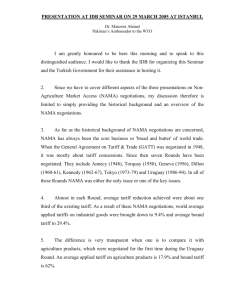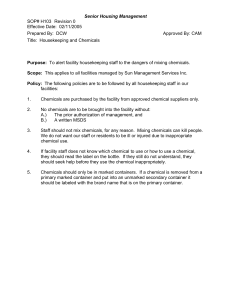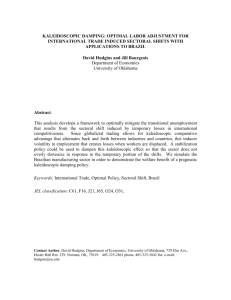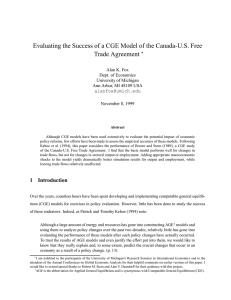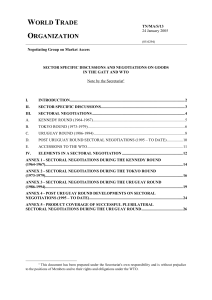TN/MA/W/18/Add.13 - Ministry of Commerce and Industry
advertisement
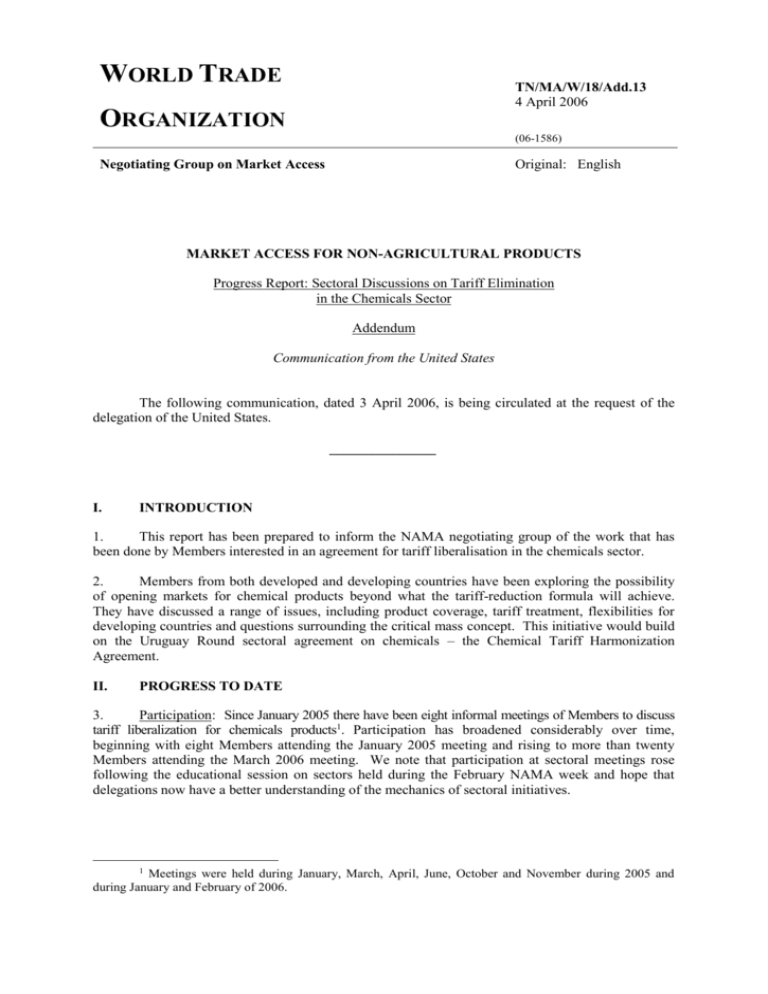
WORLD TRADE TN/MA/W/18/Add.13 4 April 2006 ORGANIZATION (06-1586) Original: English Negotiating Group on Market Access MARKET ACCESS FOR NON-AGRICULTURAL PRODUCTS Progress Report: Sectoral Discussions on Tariff Elimination in the Chemicals Sector Addendum Communication from the United States The following communication, dated 3 April 2006, is being circulated at the request of the delegation of the United States. _______________ I. INTRODUCTION 1. This report has been prepared to inform the NAMA negotiating group of the work that has been done by Members interested in an agreement for tariff liberalisation in the chemicals sector. 2. Members from both developed and developing countries have been exploring the possibility of opening markets for chemical products beyond what the tariff-reduction formula will achieve. They have discussed a range of issues, including product coverage, tariff treatment, flexibilities for developing countries and questions surrounding the critical mass concept. This initiative would build on the Uruguay Round sectoral agreement on chemicals – the Chemical Tariff Harmonization Agreement. II. PROGRESS TO DATE 3. Participation: Since January 2005 there have been eight informal meetings of Members to discuss tariff liberalization for chemicals products1. Participation has broadened considerably over time, beginning with eight Members attending the January 2005 meeting and rising to more than twenty Members attending the March 2006 meeting. We note that participation at sectoral meetings rose following the educational session on sectors held during the February NAMA week and hope that delegations now have a better understanding of the mechanics of sectoral initiatives. 1 Meetings were held during January, March, April, June, October and November during 2005 and during January and February of 2006. TN/MA/W/18/Add.13 Page 2 4. The International Council of Chemical Associations (ICCA)2, an organization of leading trade associations representing almost 75 percent of chemical manufacturing worldwide, actively supports a sectoral initiative to liberalize chemical products in the Doha Development Agenda. 5. Communications: In July 2005 a communication on market access for chemical products was circulated under the co-sponsorship of Canada, Japan, Norway, Separate Customs Territory of Taiwan, Penghu, Kinmen, and Matsu, Singapore, Switzerland, and the United States (TN/MA/W/58). In March 2006 Japan circulated a proposal on tariff liberalization in the chemicals sector. The United States has reported regularly to the NAMA negotiating group on the progress made in the chemicals sectoral initiative and will continue to do so. 6. Product Coverage: In the Uruguay Round, a group of WTO Members3 agreed to harmonize tariffs on a broad range of chemical goods to promote liberalization in this sector and to develop a more predictable and transparent global tariff structure for this industry. The result was the Chemical Tariff Harmonization Agreement (CTHA), which led to a substantial reduction and harmonization of chemical tariffs in HS Chapters 28-39. 7. Current discussions involve the expansion of both product coverage and participation in that Agreement, although the focus continues to be on participation. Japan has proposed the addition of semi-processed rubber (HS 4002-4008) to the product coverage, an idea which has received both support and resistance from certain Members. Other than Japan’s proposal on semi-processed rubber, no additional product coverage has been proposed. 8. Special and Differential Treatment: Participants have discussed that to obtain a meaningful outcome, a balance needs to be struck between the need for significant market opening by a critical mass of participants and the need to address concerns of developing countries. Members have discussed a variety of measures to account for the needs of developing countries, including longer implementation periods for all chemical products, longer implementation periods for certain products/sub-sectors, zero for “x”, and participation in certain subsectors. The United States intends to explore these options in new detail and also encourages suggestions from others. 9. Critical Mass: The chemicals products group has not reached any firm decision regarding what level of participation will be required in order to conclude a successful agreement. As a starting point, the group appears to agree that all CTHA participants should take part in this initiative. There also appears to be agreement that the chemicals sectoral initiative should include key traders, producers as well as certain Members that may not currently be major traders, but have the potential to realize growth, investment and significant trade in this sector. 2 The International Council of Chemical Associations is composed of Conselho das Associações da Indústria Quimica do Mercosul (CIQUIM), Argentina, Brazil, Paraguay and Uruguay; European Chemical Industry Council (CEFIC); Japan Chemical Industry Association (JCIA); Asociácion Nacional de la Industria Quimica (ANIQ), Mexico; Canadian Chemical Producers' Association (CCPA); American Chemistry Council (ACC), United States; New Zealand Chemical Industry Council (NZCIC); Plastics and Chemical Industry Association (PACIA), Australia. 3 Current CTHA Members include: Australia (de facto), Bulgaria, Canada, the Czech Republic, Ecuador, Estonia, the European Union, Hong Kong China, Japan, Jordan, the Republic of Korea, Mongolia, New Zealand (de facto), Norway, Panama, People's Republic of China, Qatar, Singapore, Slovakia, Switzerland, Taipei Chinese, the United Arab Emirates and the United States of America. TN/MA/W/18/Add.13 Page 3 III. NEXT STEPS 10. In order to advance these discussions, we have developed this progress report and the attached work schedule to let Members know our thoughts about moving forward. We have also provided data on trade in chemicals to further inform our thoughts regarding participation and critical mass. Our goal is to work with interested Members on the development of a “second generation” proposal for presentation and submission during the next NAMA week, April 19-21. We would then accept comments and revise the proposal accordingly prior to the April 30 deadline. __________


